-
RESEARCH01-01-2018
Being born at home is natural: care rituals for home birth
Revista Brasileira de Enfermagem. 2018;71:1247-1256
Abstract
RESEARCHBeing born at home is natural: care rituals for home birth
Revista Brasileira de Enfermagem. 2018;71:1247-1256
DOI 10.1590/0034-7167-2017-0541
Views0See moreABSTRACT
Objective:
To be aware of the care rituals developed by families when preparing for home birth during the gestational process.
Method:
Qualitative and ethnographic research developed with families during the gestational process. We adopted the observation-participation-reflection model, and the analysis was performed according to ethnonursing.
Results:
Care rituals are related to the choice of home as a place for childbirth, being characterized as a family’s rite of separation to experience this process. Other care rituals involved the preparation of the family and the eldest child as well as the home, the body, and the mind of the pregnant woman, and the choice of destination of the placenta.
Final considerations:
We must understand the birth process beyond the biological perspective, considering women and their family as a whole, within a cultural context with their beliefs and values.
-
RESEARCH01-01-2018
Violence against children and adolescents: profile and tendencies resulting from Law 13.010
Revista Brasileira de Enfermagem. 2018;71:1237-1246
Abstract
RESEARCHViolence against children and adolescents: profile and tendencies resulting from Law 13.010
Revista Brasileira de Enfermagem. 2018;71:1237-1246
DOI 10.1590/0034-7167-2017-0048
Views0See moreABSTRACT
Objective:
Describing the profile of reported violence against children and adolescents and draw an essay on the initial effects of Law 13.010 on report patterns.
Method:
Analytic study of reported cases on SINAN – Information System on Reportable Harms (from 2013 to 2015) of violence to individuals under 19, in 53 cities of Minas Gerais.
Results:
1,481 cases were reported, 49.2% before and 50.8% after Law 13.010 came to force (p = 0.5501). There was a 7% decrease on female reports and a 27.2% in male reports (p = 0.0055). It was noticed a change in report patterns (p = 0.0023), with a 130.7% increase to neglect/abandonment reports and a 33% decrease to sexual abuse report. Higher rates of violence from the parents happens at the 1 to 9-year-old age group (p < 0.0001).
Conclusion:
Main victims were women, individuals from 15 to 19 years, with aggression happening within the household; after Law 13.010, changes to patterns of victim and offender profiles and of kind of violence were noticed.
-
RESEARCH01-01-2018
Every birth is a story: process of choosing the route of delivery
Revista Brasileira de Enfermagem. 2018;71:1228-1236
Abstract
RESEARCHEvery birth is a story: process of choosing the route of delivery
Revista Brasileira de Enfermagem. 2018;71:1228-1236
DOI 10.1590/0034-7167-2016-0497
Views0See moreABSTRACT
Objective:
To analyze the discourses on the choice of the route of delivery from the perspective of women and health professionals in a public network.
Method:
The methodological approach is the discourse analysis. The data collection was through interviews and the treatment of the data was based on discourse analysis.
Results:
The categories were: 1- Between the preference and the decision there is no choice; 2- The complexity of the choice of the route of delivery; 3- It is necessary to legitimize the choice of the woman.
Final considerations:
From the perspective of women in labor the route of delivery is determined by the physician and women are not proactive. The nurses’ performance is timid, although their presence is fundamental for stimulating the physiological delivery and promoting the autonomy of women. It identifies the need for the physician to adopt a welcoming attitude, informing the women about the pros and cons involved in choosing the route of delivery.
-
RESEARCH01-01-2018
Family violence against gay and lesbian adolescents and young people: a qualitative study
Revista Brasileira de Enfermagem. 2018;71:1220-1227
Abstract
RESEARCHFamily violence against gay and lesbian adolescents and young people: a qualitative study
Revista Brasileira de Enfermagem. 2018;71:1220-1227
DOI 10.1590/0034-7167-2017-0307
Views0See moreABSTRACT
Objective:
To analyze the experiences of gay and lesbian adolescents and young people in the process of revealing sexual orientation to their families.
Method:
A qualitative study carried out in a city in the state of São Paulo. Twelve gay and lesbian adolescents and youngsters participated. For the data collection, the semi-structured interview was used and data analysis was performed using the method of interpretation of the senses.
Results:
The family reactions in the process of “coming out of the closet” of the participants were violent, with persecution and even expulsion from home, in addition to the repression of expressions of homoerotic experiences, which impacted on their health and quality of life.
Final considerations:
The family is an essential component of the support network, but also a space that can generate and reproduce forms of violence in the name of heteronormativity. Health services should develop care practices and care for the family and adolescent and homosexual youth victim of violence.
-
RESEARCH01-01-2018
Network to combat violence against rural women: articulation and communication of services
Revista Brasileira de Enfermagem. 2018;71:1212-1219
Abstract
RESEARCHNetwork to combat violence against rural women: articulation and communication of services
Revista Brasileira de Enfermagem. 2018;71:1212-1219
DOI 10.1590/0034-7167-2017-0044
Views0See moreABSTRACT
Objective:
to identify the constituent services of the network to combat violence against rural women in municipalities in the northwestern region of Rio Grande do Sul and to analyze the articulation and communication of services in search of the resolution of situations of violence.
Method:
descriptive-exploratory, qualitative study, carried out through semi-structured interviews with 26 professionals from intersectoral services, as well as managers and/or those responsible for these services. Data were systematized through content analysis.
Results:
although the professionals collectively discuss and plan coping actions, difficulties were identified in the approximation between services, related to the definition of flow, knowledge of actions/referrals, fear of seeing and reporting violence, understanding that it is not a question of demand of their field of action, and women’s access to services.
Final considerations:
it is evident the need to implement public policies that address the singularities of violence against women in rural settings.
-
RESEARCH01-01-2018
Clinical application of the Standard Operating Procedure of Positioning with Premature Infants
Revista Brasileira de Enfermagem. 2018;71:1205-1211
Abstract
RESEARCHClinical application of the Standard Operating Procedure of Positioning with Premature Infants
Revista Brasileira de Enfermagem. 2018;71:1205-1211
DOI 10.1590/0034-7167-2016-0674
Views0See moreABSTRACT
Objective:
To compare the physiological and behavioral responses of Premature Infant (PREEMIE) positioned by the Unit Routine Decubitus (URD) and the Standard Operating Procedure (SOP).
Method:
A quasi-experimental comparative study performed at a Neonatal Intensive Care Unit in Southern Brazil. We evaluated 30 PREEMIEs with gestational age ≤32 weeks, randomly assigned to Unit Routine Decubitus (URD) and Intervention Group (IG), subdivided into Right Lateral Decubitus (RLD), Dorsal Decubitus (DD), Left Lateral Decubitus (LLD) and Ventral Decubitus (VD). It was evaluated before, during and after the procedure: Heart Rate (HR); Respiratory Frequency (RF); Peripheral Oxygen Saturation (SpO2); behavior by the Neonatal Behavioral Assessment Scale (NBAS); by NIPS.
Results:
During the intervention, RR (p = 0.023), indexes in NBAS (p = 0.01) and NIPS (p <0.0001) reduced significantly in SOP. HR and SpO2 did not present a significant difference.
Conclusion:
Positioning according to the SOP shows benefit in relation to the behavioral and physiological status of PREEMIE.
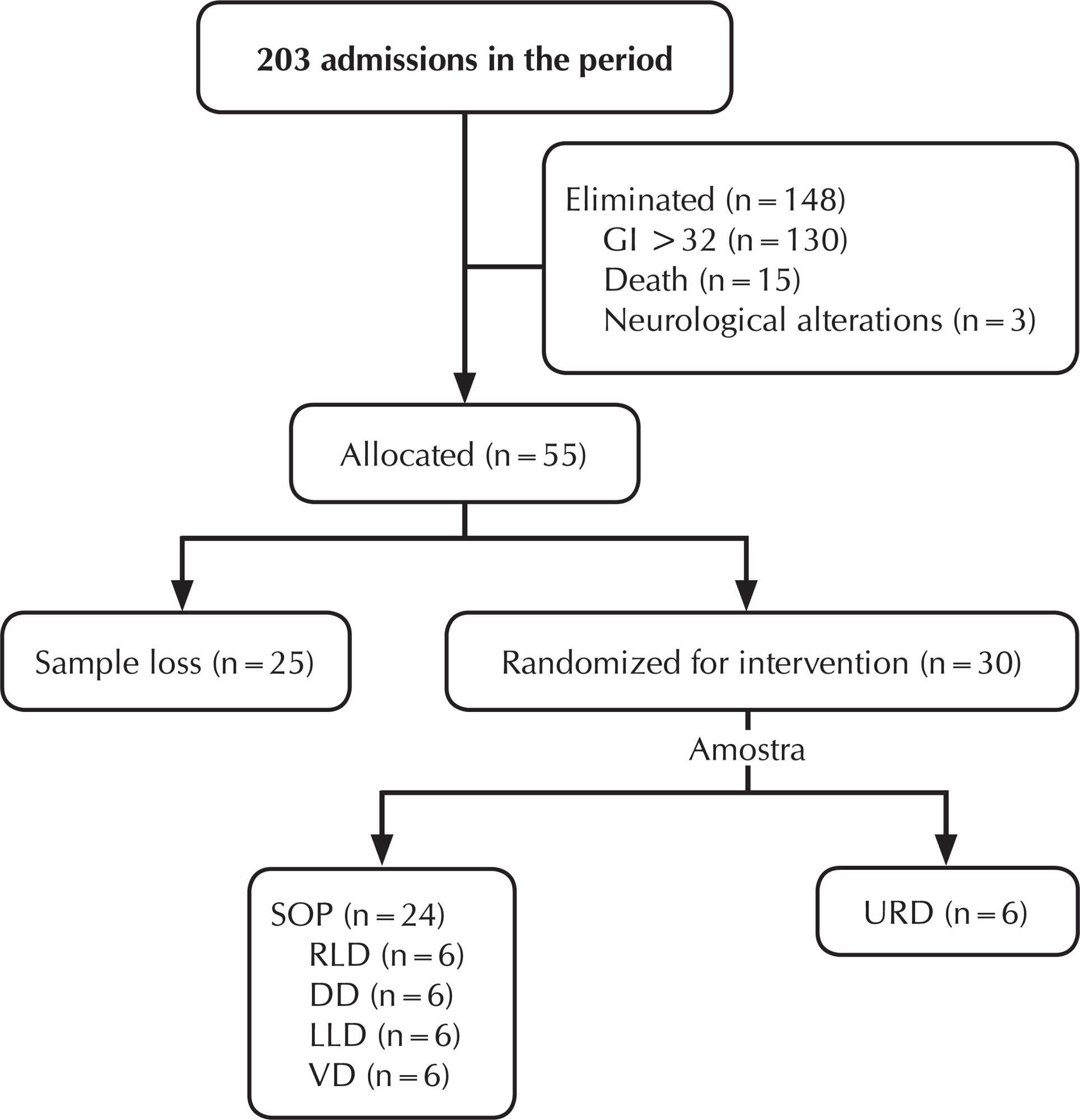
-
01-01-2018
Contributions of nursing care to women
Revista Brasileira de Enfermagem. 2018;71:1203-1204
Abstract
Contributions of nursing care to women
Revista Brasileira de Enfermagem. 2018;71:1203-1204
DOI 10.1590/0034-7167-201871sup301
Views0The situation of women and, particularly, the problems concerning their lives deserve special care by health professionals, society and mass media, in order to change their situation and boost improvements due to the condition where women were inserted decades ago and nowadays.The pregnancy-postpartum circle may be the most dramatic and exciting experience in the life […]See more -
01-01-2018
Contribuições do cuidado em enfermagem à mulher
Revista Brasileira de Enfermagem. 2018;71:1203-1204
Abstract
Contribuições do cuidado em enfermagem à mulher
Revista Brasileira de Enfermagem. 2018;71:1203-1204
DOI 10.1590/0034-7167-201871sup301
Views0A situação da mulher e, particularmente, os problemas que dizem respeito à sua vida vêm merecendo destacada atenção por parte dos profissionais de saúde, da sociedade e dos meios de comunicação, sendo focalizada por eles a necessidade de acelerar mudanças na condição que ela ocupou por décadas e ainda hoje ocupa.O ciclo gravídico-puerperal talvez seja […]See more
-
EXPERIENCE REPORT01-01-2018
Clinical and epidemiological teaching of dengue through simulated practice
Revista Brasileira de Enfermagem. 2018;71(2):451-456
Abstract
EXPERIENCE REPORTClinical and epidemiological teaching of dengue through simulated practice
Revista Brasileira de Enfermagem. 2018;71(2):451-456
DOI 10.1590/0034-7167-2016-0503
Views2See moreABSTRACT
Objective:
to describe the experience of clinical teaching on dengue and the practice of epidemiological surveillance using problematization methodology.
Method:
report of experience on educational activity with undergraduate nursing students, held in March 2016, at a public university in the city of São Paulo, conceived in four stages: dialogic lecture, active search of Aedes aegypti, case study and simulation of nursing consultation to individuals with dengue.
Results:
The activity allowed to retrieve previous knowledge about the disease, respond to exercises that addressed different clinical situations and epidemiological surveillance, including in situ evaluation of possible mosquito outbreaks, and discuss the need to expand prevention and health of the individual and the community, the impact of the media in the dissemination of cases and the coping difficulties experienced in the different levels of attention.
Conclusion:
the methodology adopted enabled qualified training of students to cope with dengue.

-
ORIGINAL ARTICLE07-18-2022
Beliefs, knowledge, actions of nursing techniques in breastfeeding in pain management in immunization
Revista Brasileira de Enfermagem. 2022;75(6):e20210546
Abstract
ORIGINAL ARTICLEBeliefs, knowledge, actions of nursing techniques in breastfeeding in pain management in immunization
Revista Brasileira de Enfermagem. 2022;75(6):e20210546
DOI 10.1590/0034-7167-2021-0546
Views1See moreABSTRACT
Objective:
Understand the beliefs, knowledge, and actions of nursing technicians on breastfeeding as a form of non-pharmacological intervention to relieve pain in newborns and infants during immunization.
Methods:
Qualitative study carried out through semi-structured interviews with nine nursing technicians from three Basic Health Units in a city in the state of São Paulo. The theoretical approach of the Belief Model and the methodological framework of Thematic Analysis supported this study.
Results:
Three themes originated: Beliefs, Knowledge, and Actions of nursing technicians.
Final considerations:
Despite knowledge about the benefits of breastfeeding as the most effective method for relieving pain in newborns and infants during vaccination, their restrictive beliefs overrode the evidence, leading them to act in ways that discourage or prevent the mother from breastfeed during vaccination. Formal training is recommended to align with current evidence-based practices.
-
REVIEW12-08-2023
Educational technologies for accident prevention due to falls in childhood: a scoping review
Revista Brasileira de Enfermagem. 2023;76:e20220807
Abstract
REVIEWEducational technologies for accident prevention due to falls in childhood: a scoping review
Revista Brasileira de Enfermagem. 2023;76:e20220807
DOI 10.1590/0034-7167-2022-0807
Views2See moreABSTRACT
Objectives:
to map evidence on educational technology use for accident prevention due to falls in childhood.
Methods:
a scoping review, carried out in October and November 2022, in the MEDLINE, Web of Science, BDENF and CINAHL databases and LILACS bibliographic index. There was no delimitation of language or time. Data were extracted and analyzed descriptively by two independent researchers. The research protocol was registered in the Open Science Framework.
Results:
twenty-six studies were selected. Booklets, pamphlets and leaflets were the most used technologies, presenting health services as the most frequent environment to develop research on fall prevention. The technologies developed were important outcomes: increased knowledge of children, family members, caregivers, health and education professionals.
Conclusions:
educational technology use makes it possible to increase knowledge, adopt safe practices and reduce falls.

-
REVIEW03-15-2024
Resources for health literacy among caregivers of prematurely born children: a scoping review
Revista Brasileira de Enfermagem. 2024;77(1):e20230062
Abstract
REVIEWResources for health literacy among caregivers of prematurely born children: a scoping review
Revista Brasileira de Enfermagem. 2024;77(1):e20230062
DOI 10.1590/0034-7167-2023-0062
Views1See moreABSTRACT
Objectives:
to map the available evidence on resources used to promote health literacy among caregivers of prematurely born children during outpatient follow-up.
Methods:
the Joanna Briggs Institute’s scope review protocol was utilized. The search encompassed six databases, incorporating studies from 2012 to 2022.
Results:
the three included publications revealed that the resources employed are: mobile applications, phone calls, individual counseling, videos, educational pamphlets, and group discussions. Implementing an education protocol during the transition home enhances scientifically grounded health promotion rates.
Conclusions:
there is limited literature addressing the health literacy of these caregivers. The nursing team plays a crucial role in health education and in developing resources applicable to these families.

-
ORIGINAL ARTICLE01-13-2024
Social representations of oncologic surgery for patients with cancer
Revista Brasileira de Enfermagem. 2024;77(6):e20230273
Abstract
ORIGINAL ARTICLESocial representations of oncologic surgery for patients with cancer
Revista Brasileira de Enfermagem. 2024;77(6):e20230273
DOI 10.1590/0034-7167-2023-0273
Views2See moreABSTRACT
Objectives:
to analyze the social representations of patients with cancer regarding oncologic surgery.
Methods:
a qualitative study based on Social Representation Theory was conducted with 126 participants between October 2021 and May 2022 in a public hospital in Rio de Janeiro. A characterization questionnaire, free evocations of the inducing term “surgery”, and semi-structured interviews with 60 participants were applied. Data were analyzed using Microsoft Excel® and IRaMuTeQ.
Results:
the central core of the representation is composed of fear, cure, hope, and removing the disease. The analysis of interviews resulted in six classes that highlight the social changes caused by treatment as well as the need for a support network to cope with the surgical process.
Final Considerations:
the representations reflect fear and hope towards the procedure and the desire to remove the disease, thus translating the cure through surgery.

-
ORIGINAL ARTICLE01-13-2024
Nurses’ perspectives on the use of telemonitoring in the management of people with diabetes and hypertension
Revista Brasileira de Enfermagem. 2024;77(6):e20230481
Abstract
ORIGINAL ARTICLENurses’ perspectives on the use of telemonitoring in the management of people with diabetes and hypertension
Revista Brasileira de Enfermagem. 2024;77(6):e20230481
DOI 10.1590/0034-7167-2023-0481
Views3See moreABSTRACT
Objectives:
to understand the perspective of nurses on the use of telemonitoring in the management of people with type 2 diabetes mellitus and arterial hypertension in primary care.
Methods:
this qualitative research involved sixteen nurses from eight municipalities in Paraná. Data were collected between November 2022 and January 2023 through inperson or remote interviews, which were audio-recorded and subjected to content analysis.
Results:
according to the nurses, telemonitoring enhances users’ knowledge about these conditions, communication and connection with the team, and productivity. However, the lack of electronic resources and equipment, high staff turnover, low user adherence, and the limited availability of professional time present significant challenges.
Final Considerations:
the effective implementation and operation of telemonitoring in the management of people with diabetes and hypertension involve both potential benefits and barriers. It is essential to have the availability of human and technological resources, managerial support, and the commitment of professionals and users.
-
ERRATUM01-13-2024
ERRATUM
Revista Brasileira de Enfermagem. 2024;77(6):e2024n6e08
Abstract
ERRATUMERRATUM
Revista Brasileira de Enfermagem. 2024;77(6):e2024n6e08
DOI 10.1590/0034-7167.20247706e08
Views2In the article “Brazilian nursing specific situation, middle and micro-range theories: a bibliometric study”, with DOI number: , published in Revista Brasileira de Enfermagem, 2024;77(4):e20230520, Chart 1:Where it read:[…]See more -
ORIGINAL ARTICLE09-29-2022
Palliative care production for health professionals in the context of home care
Revista Brasileira de Enfermagem. 2022;75(1):e20210030
Abstract
ORIGINAL ARTICLEPalliative care production for health professionals in the context of home care
Revista Brasileira de Enfermagem. 2022;75(1):e20210030
DOI 10.1590/0034-7167-2021-0030
Views1See moreABSTRACT
Objectives:
to analyze palliative care production developed by health professionals to home care patients.
Methods:
this is an exploratory study, with a qualitative approach, using the transpersonal care theoretical framework. Thirteen interviews were conducted with health professionals and 18 observations were conducted on different cases. Content analysis was performed using MAXQDA©.
Results:
actions performed: maintenance and follow-up measures to people eligible for palliative care, in acts of dialogue and “listening” to caregivers and users, conducting guidelines for the care and self-care process, performing technical procedures, delivery of materials, referrals and medical prescriptions to users.
Final Considerations:
it is perceived the need for advances in the implementation of government policies in Brazil that insert palliative care into the Health Care Network through educational, managerial and care actions that ensure human dignity, thus allowing the development of these and other palliative care interventions.
-
REVIEW06-17-2020
Prevention and conduct against the Extravasation of antineoplastic chemotherapy: a scoping review
Revista Brasileira de Enfermagem. 2020;73(4):e20190008
Abstract
REVIEWPrevention and conduct against the Extravasation of antineoplastic chemotherapy: a scoping review
Revista Brasileira de Enfermagem. 2020;73(4):e20190008
DOI 10.1590/0034-7167-2019-0008
Views0See moreABSTRACT
Objectives:
to identify and synthesize scientific evidence on prevention and management of extravasation of antineoplastic agents in adult patients by nurses.
Methods:
scoping review, according to Joanna Briggs Institute and PRISMA-ScR. Research was conducted in five electronic databases, Cochrane Library and eight catalogs of theses and dissertations. Data collection occurred from April to July 2018, with no time limit. The extracted data were analyzed and synthesized in a narrative way.
Results:
a total of 3,110 records were retrieved and 18 studies were kept for review. Most publications (66.6%) had a qualitative approach and addressed both aspects, i.e., prevention and management of extravasation of chemotherapy in adult patients.
Conclusions:
the implementation of protocols based on scientific evidence on prevention and management of extravasation of antineoplastic agents is paramount in order to provide patient safety and support to the nursing staff.
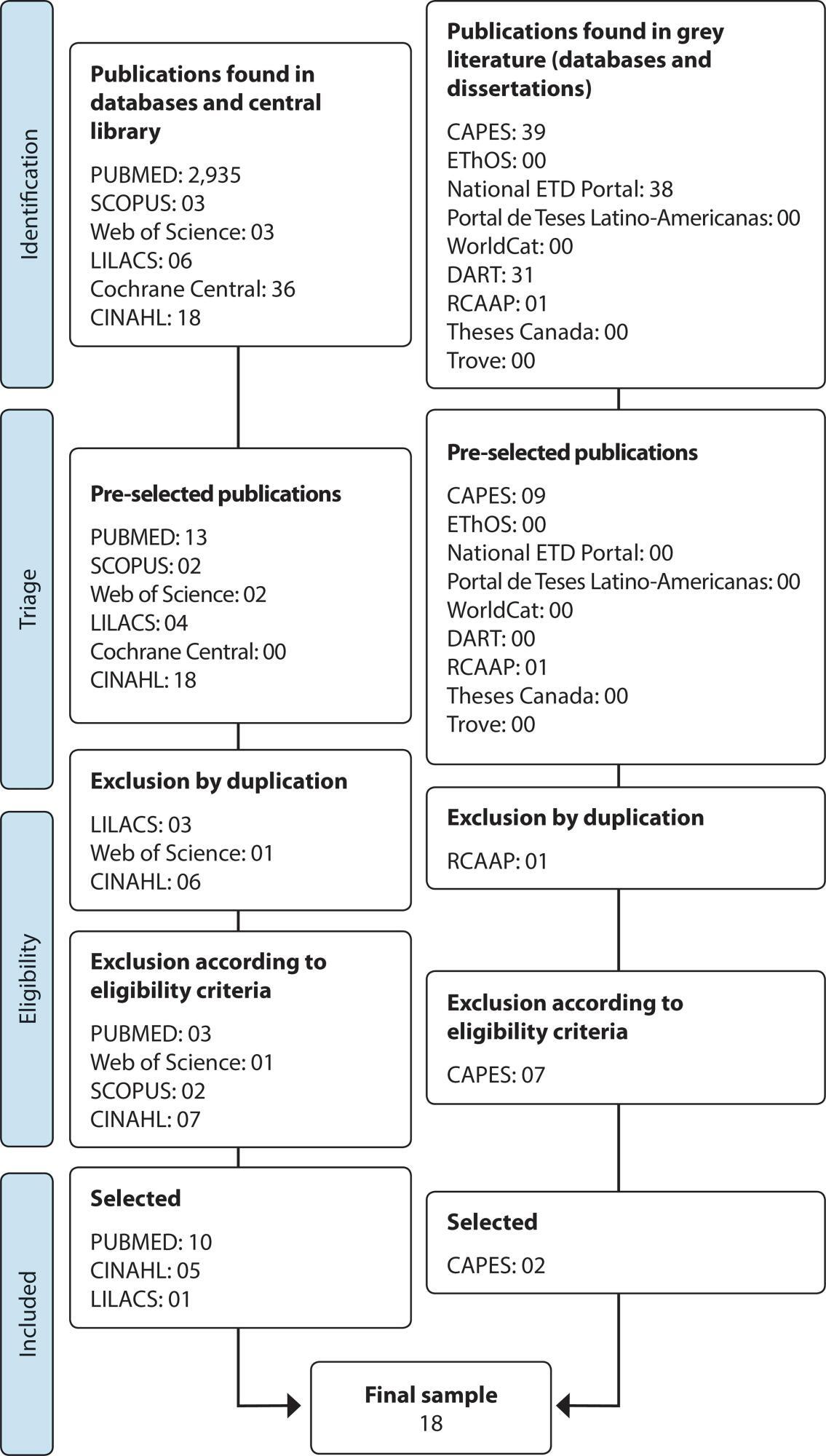
-
ORIGINAL ARTICLE06-01-2020
Paulo Freire’s research itinerary: contributions for promoting health in the teaching profession
Revista Brasileira de Enfermagem. 2020;73(4):e20190164
Abstract
ORIGINAL ARTICLEPaulo Freire’s research itinerary: contributions for promoting health in the teaching profession
Revista Brasileira de Enfermagem. 2020;73(4):e20190164
DOI 10.1590/0034-7167-2019-0164
Views0See moreABSTRACT
Objectives:
examine Paulo Freire’s research itinerary as a theoretical-methodological framework and its contributions for promoting health in the teaching profession.
Methods:
qualitative participatory action research coordinated with Paulo Freire’s itinerary, carried out in culture circles, from April 18, 2018 to June 26, 2018. It involved the participation of 21 teachers from a federal teaching institution.
Results:
the method that was used promoted dialogue and reflection among the participants, enabling a health promotion intervention. It facilitated self-knowledge and reflection, resulting in significant changes in the participants, in a process in pursuit that seeks transformations.
Final Considerations:
Paulo Freire’s research itinerary was opportune, as a possibility for promoting health, mainly in terms of providing a framework that assists in the practical construction of knowledge and encourages participants to examine their reality in the pursuit of enhanced quality of life.
-
ORIGINAL ARTICLE07-08-2020
Patient safety: perception of family members of hospitalized children
Revista Brasileira de Enfermagem. 2020;73(5):e20190525
Abstract
ORIGINAL ARTICLEPatient safety: perception of family members of hospitalized children
Revista Brasileira de Enfermagem. 2020;73(5):e20190525
DOI 10.1590/0034-7167-2019-0525
Views0See moreABSTRACT
Objectives:
to know the meaning attributed by family members to the health safety of pediatric patients, with attention to the possibilities of their collaboration.
Methods:
this qualitative study was conducted with eighteen family members of children hospitalized in a pediatric unit, from January to July 2018. Symbolic Interactionism was used as a theoretical framework, and Inductive Content Analysis as method.
Results:
child hospitalization poses risks to possible incidents and adverse events. Participants and professionals are responsible for patient safety. Thus, their actions focus on error prevention. Therefore, they seek information and observe in a vigil way professional care in classic aspects of safety. They conceive essential and favoring safety the approach centered on children and family members.
Final Considerations:
family members recognized the chances of errors and care damage, identified themselves as support in minimizing damage and were in partnership with the professional, increasing chances of effecting safety.
-
05-21-2021
Quality of life and falls in elderly people: a mixed methods study
Revista Brasileira de Enfermagem. 2021;74:e20200400
Abstract
Quality of life and falls in elderly people: a mixed methods study
Revista Brasileira de Enfermagem. 2021;74:e20200400
DOI 10.1590/0034-7167-2020-0400
Views0See moreABSTRACT
Objective:
to assess elderly people’s quality of life, understanding the social representations of falls.
Methods:
a convergent mixed methods research carried out at homes, with a sample of 134 elderly people. A structured questionnaire was used, covering sociodemographic variables and factors that indicated frailty and risk of falling. For quality of life assessment, Medical Outcomes Study Short-Form 36 and Theory of Social Representations, Abric’s structural approach were used, with data treated by dictionary of equivalent terms, processed in Evoc 2000, converging analytically according to Neuman.
Results:
quality of life impairment was identified in terms of physical, emotional and functional capacity. The elements of the possible central nucleus were fall, fear, and bruised-broken-bone.
Final considerations:
quality of life impairment can contribute to increase the number of falls, which has been shown to be an event present in elderly people’s lives through evocations. Understanding elderly people’s individual demands allows planning actions.
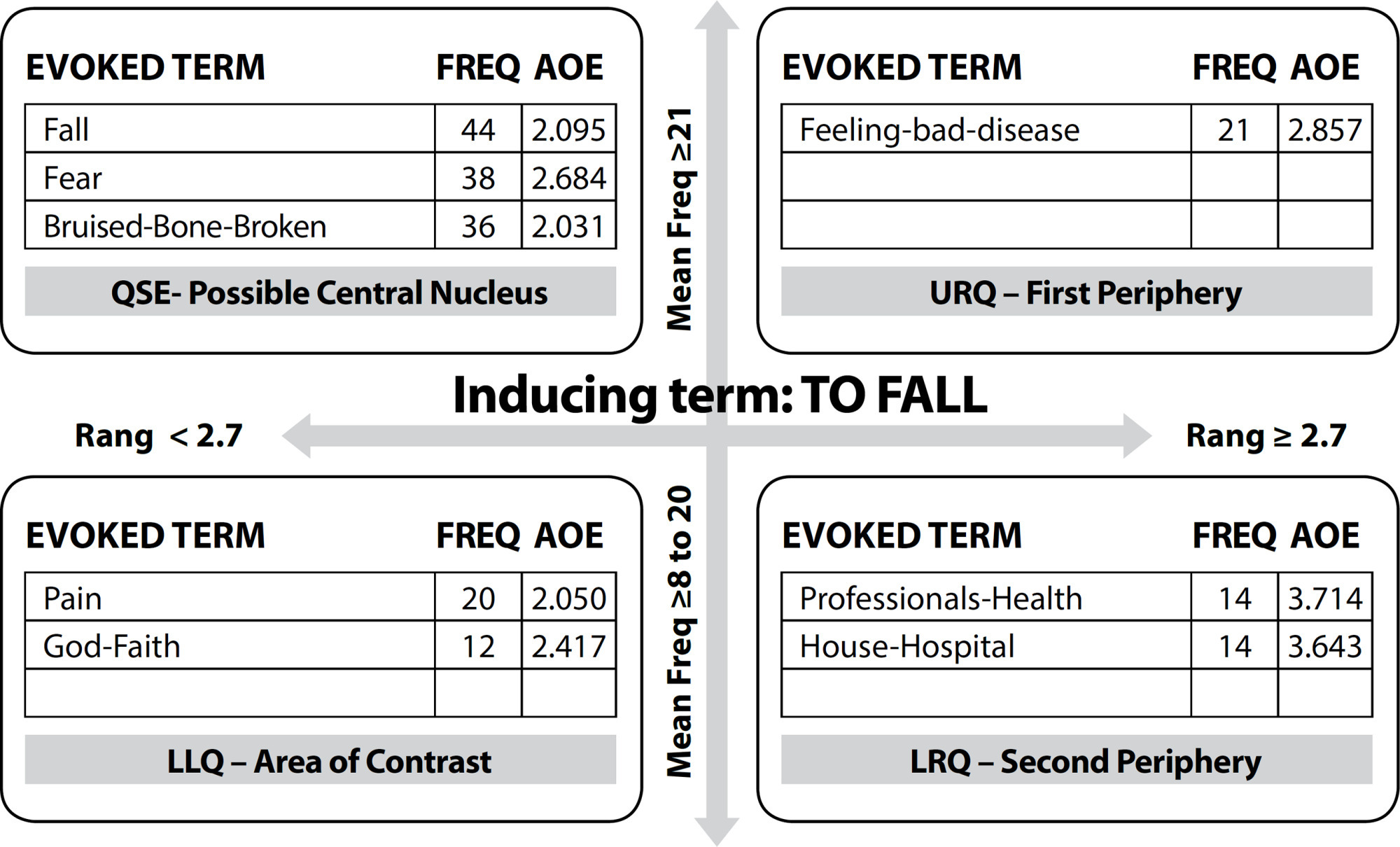
-
ORIGINAL ARTICLE06-08-2020
Understanding the dramatic therapeutic play session: a contribution to pediatric nursing
Revista Brasileira de Enfermagem. 2020;73(4):e20180812
Abstract
ORIGINAL ARTICLEUnderstanding the dramatic therapeutic play session: a contribution to pediatric nursing
Revista Brasileira de Enfermagem. 2020;73(4):e20180812
DOI 10.1590/0034-7167-2018-0812
Views0See moreABSTRACT
Objectives:
to understand how the dramatic therapeutic play session occurs within the care of hospitalized children.
Methods:
qualitative multiple case study, using theoretical references, such as symbolic interactionism and Vygotsky’s theory of symbolic play. Twenty play sessions performed with six children from 3 to 10 years old were analyzed, each corresponding to one case.
Results:
these sessions demonstrated that a dramatic therapeutic play session is a process of four interdependent and complementary steps: bonding, exploring, dramatizing, and play cessation. They also revealed the imaginary situations externalized by the child, the importance of the exploration step for which they manage the imaginary situation and catharsis, and how her higher psychological faculties are articulated during this process.
Final Considerations:
the results contribute to the understanding of the conduct and analysis of the dramatic therapeutic play session, reinforcing the importance of its use in pediatric nursing care practice.
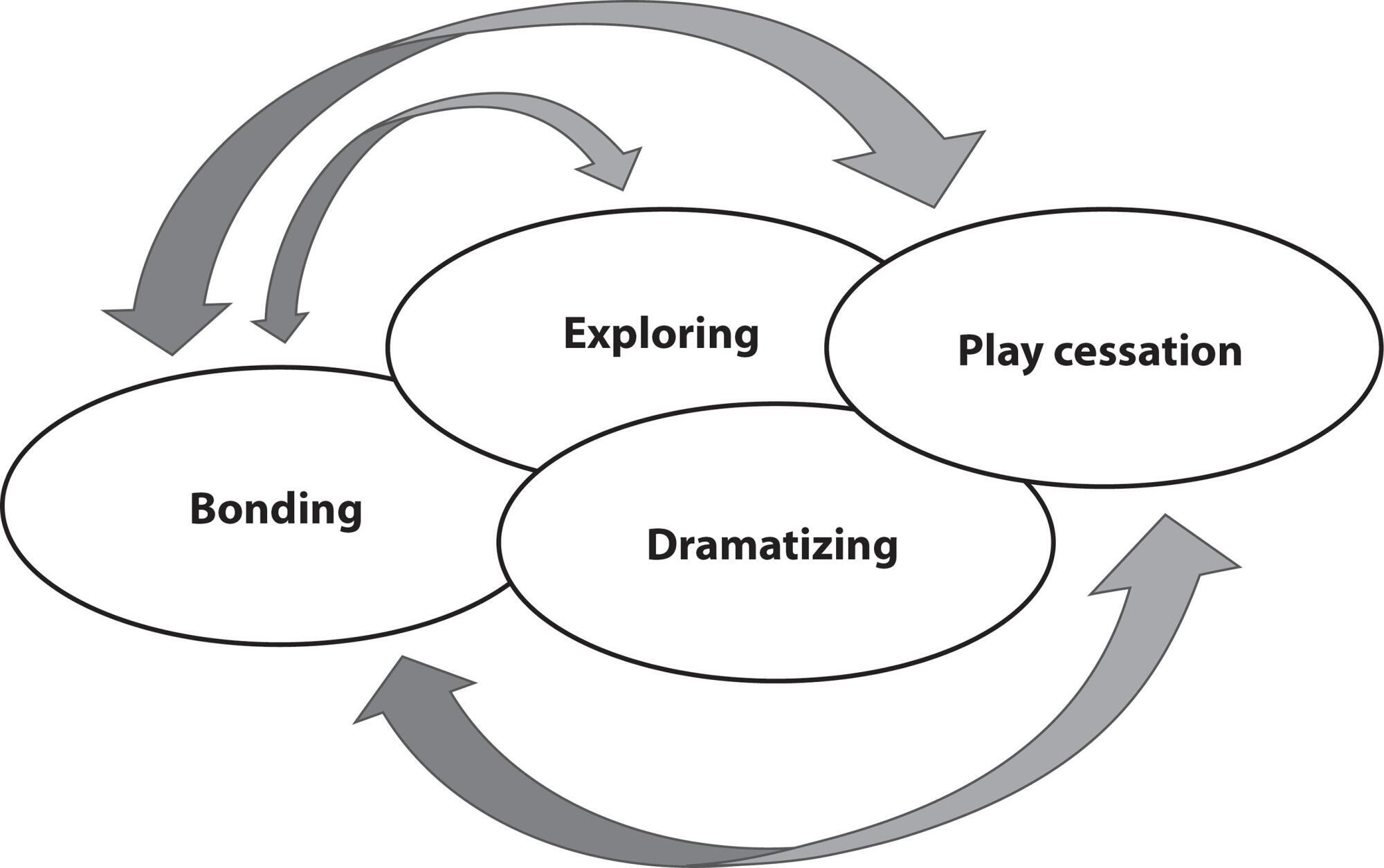
-
04-14-2021
Nurse-midwives reconfiguring care in the scope of labor and births in COVID-19 times
Revista Brasileira de Enfermagem. 2021;74:e20200863
Abstract
Nurse-midwives reconfiguring care in the scope of labor and births in COVID-19 times
Revista Brasileira de Enfermagem. 2021;74:e20200863
DOI 10.1590/0034-7167-2020-0863
Views0See moreABSTRACT
Objectives:
to analyze how the nurse-midwives of maternity wards that were fields of practice for an improvement course in obstetrics have reorganized care in the context of labor and birth amidst the COVID-19 pandemic.
Methods:
this is a descriptive, exploratory and qualitative study carried out with nine nurse-midwives who are preceptors and collaborators in maternity wards that were fields of practice for an improvement course, between February and April 2020, through a semi-structured interview through WhatsApp®. Content analysis was used to treat the information.
Results:
the pandemic brought the need to reorganize work, with a focus on service training and maintenance of good practices in labor and birth, whose movement was intensely experienced, interfering in nurse-midwives’ mental health.
Conclusion:
nurse-midwives have faced the pandemic with concerns about maintaining safe care, focused on practices based on updated scientific evidence.
-
ORIGINAL ARTICLE12-16-2023
School Nursing Guide for student health promotion: construction and validity
Revista Brasileira de Enfermagem. 2023;76(1):e20220260
Abstract
ORIGINAL ARTICLESchool Nursing Guide for student health promotion: construction and validity
Revista Brasileira de Enfermagem. 2023;76(1):e20220260
DOI 10.1590/0034-7167-2022-0260
Views0See moreABSTRACT
Objectives:
to describe the process of construction and validity of a School Nursing Guide for student health promotion.
Methods:
a methodological study, carried out from February to December 2021, composed of Convergent Care Research based on Pender’s Health Promotion Model. Based on the literature and dialogue with 11 nurses in the seven online focus groups, actions were constructed. Subsequently, 24 judges assessed content and appearance.
Results:
the guide proposes strategies for developing school nursing practices focusing on health promotion. The Appearance Validity Index ranged from 0.63 to 1.0, and the total was 0.84. The Content Validity Index ranged from 0.95 to 1.0, and the total was 0.997.
Conclusions:
the guide incorporated the needs of young people recognized by professionals, and the assessment phase confirms its validity, and can be used in the context of practice with young people.
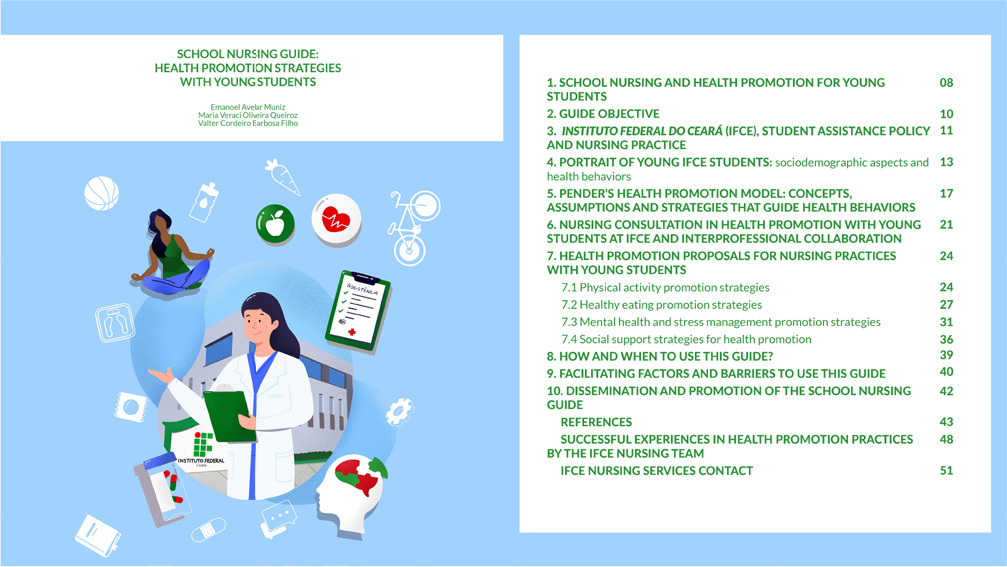
-
REFLECTION09-07-2020
Training and work process in Multiprofessional Residency in Health as innovative strategy
Revista Brasileira de Enfermagem. 2020;73(6):e20190635
Abstract
REFLECTIONTraining and work process in Multiprofessional Residency in Health as innovative strategy
Revista Brasileira de Enfermagem. 2020;73(6):e20190635
DOI 10.1590/0034-7167-2019-0635
Views0See moreABSTRACT
Objectives: To
reflect about education in health and work process on three programs of multiprofessional residency in Florianópolis/SC.
Method:
Reflexive study about Multiprofessional Residency Health Programs of Florianópolis.
Results:
Multiprofessional Residency characterizes training health professionals through service education. Developing these professionals’ specialization with assignments that promote professional exercise and magnifies multiprofessional work at the same time, for excellency in unabridged healthcare.
Final Considerations:
Multiprofessional Residency Programs make interdisciplinary education, sharing knowledge between residents and other professionals stimulating development of innovation skills.
Search
Search in:
Nuvem de Tags
Adolescente (85) Atenção Primária à Saúde (239) COVID-19 (91) Criança (91) Cuidados de Enfermagem (269) Educação em Enfermagem (151) Educação em Saúde (139) Enfermagem (930) Enfermagem Pediátrica (86) Estudantes de Enfermagem (77) Estudos de Validação (131) Família (87) Idoso (208) Promoção da Saúde (99) Qualidade de Vida (104) Saúde do Trabalhador (86) Saúde Mental (145) Saúde Pública (82) Segurança do Paciente (150) Tecnologia Educacional (100)



